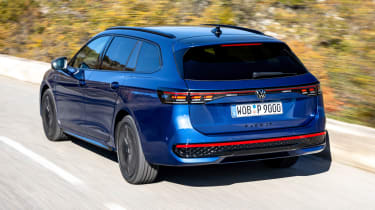Volkswagen Passat PHEV 2024 review: the most versatile estate VW has ever made
Pricing will be key, but for now the plug-in hybrid Volkswagen Passat is an impressive all-round car

Verdict
A dent in boot space is the only major downside to the new Volkswagen Passat plug-in hybrid as it stands. Pricing, of course, will ultimately determine if it’ll outshine its many decent rivals (the new Skoda Superb being atop that list). The plug-in hybrid’s range is outstanding and the recharge rate would allow most to run it almost exclusively as an electric car. With that in mind, the new Passat PHEV is certainly the most versatile estate Volkswagen has ever made.
It’s a sign of the times that the new Volkswagen Passat is only offered in estate form, but also without the once ubiquitous TDI diesel engine. A range of mild-hybrid Passats are available from launch, but Volkswagen says the upcoming plug-in hybrids will be the most popular versions of its long-running family favourite and it’s one of those we’re driving here.
Just like with a fully-electric vehicle, the first question on people’s minds when it comes to plug-in hybrids is range and it’s good news in this regard from the Passat. Volkswagen claims it’ll reach 62 miles on a charge, which is 25 miles more than the old Passat GTE. It’s also 28 miles more than the BMW 330e Touring, but three miles off the Mercedes C 300 e Estate.
Used - available now

2018 Volkswagen
Passat
78,970 milesAutomaticDiesel2.0L
Cash £10,795
2022 Volkswagen
Passat
51,470 milesManualDiesel2.0L
Cash £15,700
2024 Volkswagen
Passat
24,667 milesAutomaticPetrol1.5L
Cash £23,700
2024 Volkswagen
Passat
45,542 milesAutomaticPetrol1.5L
Cash £19,300This range figure is also identical to the one offered by the new Skoda Superb Estate PHEV, which shouldn’t come as a surprise given Skoda led the development of the new Passat alongside its third-generation Superb. The omens are good for the Passat because we were impressed by the Superb in its prototype form last year.
The 1.5-litre four-cylinder petrol engine replaces the old 1.4-litre unit and the new 19.7kWh battery is more than double the size of the old one. The Passat PHEV we’re testing here is the less powerful model with 201bhp and 350Nm of torque, a smidge down on the old GTE’s 215bhp and total system torque of 400Nm. The more powerful VW Passat PHEV comes with 268bhp and 400Nm of torque for a 7.4-second 0-62mph time (0.6 seconds faster than our car).
In electric-only mode there’s a useful 114bhp from the electric motor and plenty of torque. We tried it in this mode and came away impressed by the levels of refinement on offer, a battery level of 90 per cent and a range figure of 57 miles when we jumped in suggest the final WLTP-rated car should reach VW’s lengthy claimed range. A rapid recharge rate of up to 50kW means a 10 to 80 per cent top up takes just 25 minutes, too.
The Passat certainly doesn’t feel slow in this guise. Volkswagen tells us the plug-in hybrid system is better integrated than before, not just the engine and electric system - but the gearbox, too. As a result it’s brilliantly smooth at shifting between the two power outputs when needed and the gearbox is rarely caught-out by sudden prods at the accelerator.
At 1,808kg it would be ridiculous to call the Volkswagen Passat PHEV light, but in a world chock full of two-and-a-half tonne SUVs, it’s not a bad figure. Especially, considering the larger battery and the car’s overall size.
Volkswagen tells us this car is still a prototype and subject to finalisation, but it felt like the finished article to us (aside from the airbag light on the dash that went into strobe-light mode, that is). The new DDC system (standing for Dynamic Chassis Control) can adjust the stiffness of the dampers across 15 levels, which means there’s a fair bit of change between the softest and hardest setting. The generally placid persona of the Passat means you’re much better served keeping it towards the more comfortable end of the spectrum - which is where the big VW really impresses on the move.
In spite of the huge 15-inch touchscreen, there’s some old-school Volkswagen charm to the interior’s simplicity and quality. There’s a little graphic on the passenger side to liven up the dash (otherwise it would be pretty dull up front), but it’s the small things like the door handles, air vents and the physical buttons in place of touch sensitive panels that all help provide a sturdy and classy feel.
We’ve already tried the infotainment itself when we drove the mild-hybrid Passat and while the design and resolution of the screen makes it look crisp, there are some setbacks such as the widgets not being easy enough to use and the vast array of sub menus.
With Skoda taking on development of the Passat, boot space was always going to be a real plus point. The standard mild-hybrid has a segment-leading 690-litre boot, but the plug-in hybrid sees this drop to 510 litres. Still, that’s 27 litres more than the old Passat GTE estate.
| Model: | Volkswagen Passat plug-in hybrid |
| Price from: | £45,000 (est) |
| Powertrain: | 1.5-litre four-cylinder petrol + 19.7kWh battery |
| Power/torque | 201bhp/350Nm |
| Transmission: | Six-speed dual-clutch automatic |
| 0-62mph: | 8 seconds |
| Top speed: | 142mph |
| Electric range: | 62 miles (WLTP TBC) |
| Economy/CO2 | TBC |
| Size (H/L/W): | 4,917mm/1,849mm/1,497mm |
| On sale: | Q3 2024 |








